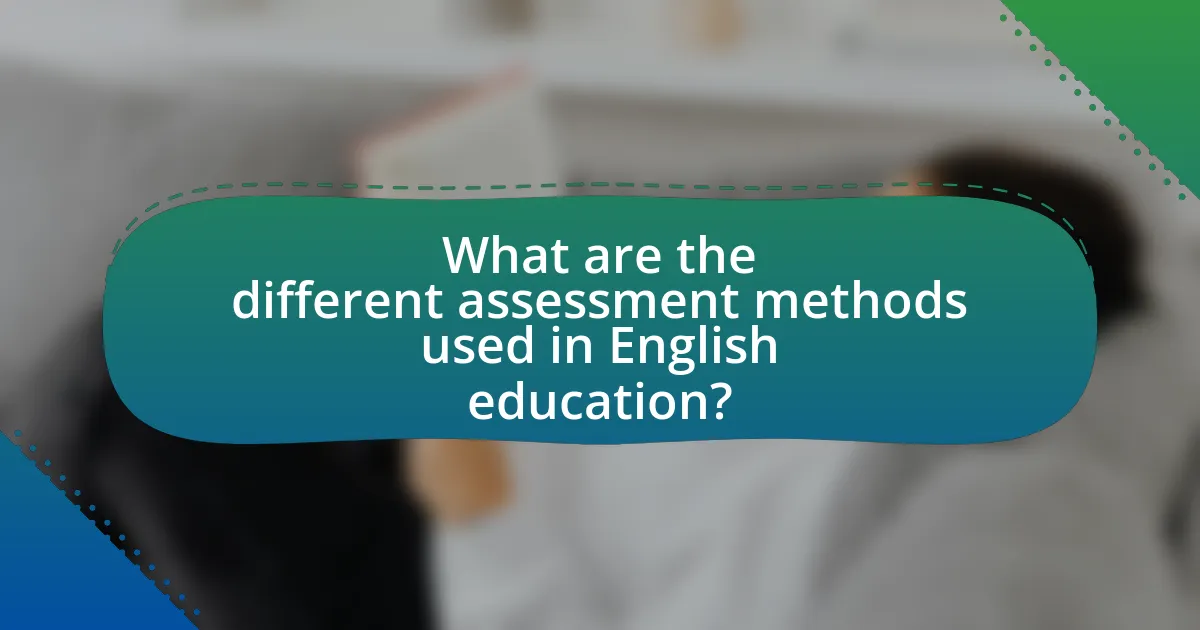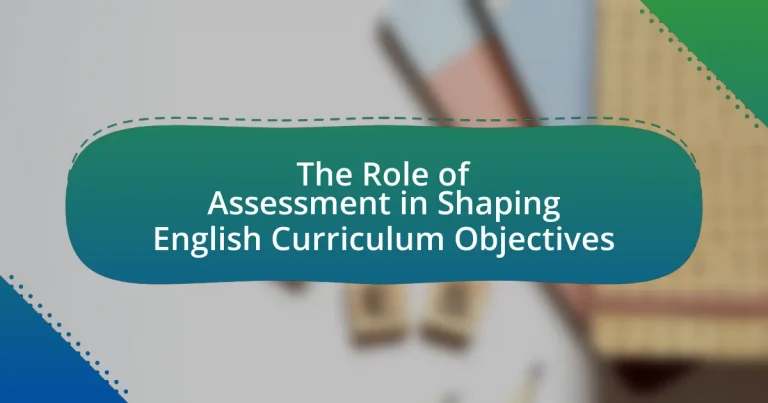The article examines the critical role of assessment in shaping English curriculum objectives, highlighting how various assessment methods provide measurable data that informs instructional strategies and curriculum design. It discusses the influence of formative and summative assessments on curriculum development, the types of assessments commonly used, and the impact of standardized tests on educational outcomes. Additionally, the article outlines best practices for integrating assessment into curriculum planning, the challenges educators face, and the resources available to support effective assessment practices in English education. Overall, it emphasizes the importance of a data-driven approach to enhance student learning and align curriculum objectives with actual student needs.

What is the Role of Assessment in Shaping English Curriculum Objectives?
Assessment plays a critical role in shaping English curriculum objectives by providing measurable data that informs instructional strategies and curriculum design. Through various assessment methods, educators can identify students’ strengths and weaknesses, which directly influences the development of targeted learning objectives. For instance, standardized assessments reveal trends in student performance, guiding curriculum adjustments to better meet learners’ needs. Additionally, formative assessments allow for ongoing feedback, enabling educators to refine objectives based on real-time student progress. This data-driven approach ensures that curriculum objectives remain relevant and effective in fostering language proficiency and critical thinking skills among students.
How does assessment influence curriculum design in English education?
Assessment directly influences curriculum design in English education by determining the learning objectives and instructional strategies that educators implement. Through formative and summative assessments, educators gather data on student performance, which informs necessary adjustments to the curriculum to meet diverse learning needs. For instance, standardized test results can highlight areas where students struggle, prompting curriculum developers to incorporate targeted interventions or additional resources. Research indicates that aligning assessments with curriculum goals enhances student engagement and achievement, as evidenced by studies showing improved outcomes when assessments are integrated into the learning process.
What types of assessments are commonly used in English curriculum development?
Commonly used assessments in English curriculum development include formative assessments, summative assessments, diagnostic assessments, and performance-based assessments. Formative assessments, such as quizzes and class discussions, provide ongoing feedback to inform instruction. Summative assessments, like final exams and standardized tests, evaluate student learning at the end of an instructional period. Diagnostic assessments identify students’ strengths and weaknesses before instruction begins, while performance-based assessments require students to demonstrate their skills through projects or presentations. These assessment types collectively guide curriculum design and instructional strategies, ensuring alignment with educational standards and learning objectives.
How do formative and summative assessments differ in their impact on curriculum objectives?
Formative and summative assessments differ significantly in their impact on curriculum objectives, with formative assessments focusing on ongoing feedback to enhance learning, while summative assessments evaluate student learning at the end of an instructional period. Formative assessments, such as quizzes and class discussions, provide real-time insights that inform instructional adjustments, thereby aligning curriculum objectives with student needs. In contrast, summative assessments, like final exams or standardized tests, measure the extent to which curriculum objectives have been met, often influencing future curriculum design and resource allocation. Research indicates that formative assessments can lead to improved student performance by fostering a growth mindset, while summative assessments serve as accountability measures for educational institutions, ensuring that curriculum objectives are effectively achieved.
Why is assessment considered a critical component of curriculum objectives?
Assessment is considered a critical component of curriculum objectives because it provides measurable evidence of student learning and progress. This measurement allows educators to evaluate the effectiveness of the curriculum and make necessary adjustments to enhance teaching and learning outcomes. Research indicates that effective assessment practices, such as formative assessments, can lead to improved student performance by identifying areas of strength and weakness, thereby informing instructional strategies. For example, a study by Black and Wiliam (1998) in “Assessment and Classroom Learning” highlights that formative assessment significantly boosts student achievement when integrated into the learning process.
What are the key benefits of integrating assessment into curriculum planning?
Integrating assessment into curriculum planning enhances educational effectiveness by ensuring alignment between learning objectives and evaluation methods. This alignment allows educators to identify student learning gaps and adjust instructional strategies accordingly, leading to improved student outcomes. Research indicates that formative assessments, when integrated into curriculum design, can increase student engagement and motivation, as they provide ongoing feedback that supports learning. For instance, a study by Black and Wiliam (1998) in “Assessment and Classroom Learning” found that formative assessment practices can lead to significant gains in student achievement.
How does assessment help in identifying student learning needs?
Assessment helps in identifying student learning needs by providing measurable data on student performance and understanding. Through various assessment methods, educators can pinpoint specific areas where students struggle or excel, allowing for targeted interventions. For instance, formative assessments, such as quizzes and class discussions, reveal gaps in knowledge and skills, enabling teachers to adjust instruction accordingly. Research indicates that assessments can lead to improved learning outcomes; a study by Black and Wiliam (1998) found that formative assessment significantly enhances student achievement when used effectively. Thus, assessment serves as a critical tool in tailoring educational approaches to meet diverse learning needs.

What are the different assessment methods used in English education?
The different assessment methods used in English education include formative assessments, summative assessments, diagnostic assessments, and performance-based assessments. Formative assessments, such as quizzes and class discussions, provide ongoing feedback to improve student learning. Summative assessments, like final exams and standardized tests, evaluate student learning at the end of an instructional unit. Diagnostic assessments identify students’ strengths and weaknesses before instruction begins, allowing for tailored teaching approaches. Performance-based assessments, including presentations and projects, measure students’ ability to apply their knowledge in real-world contexts. These methods collectively inform curriculum development and instructional strategies, ensuring alignment with educational objectives.
How do standardized tests shape English curriculum objectives?
Standardized tests shape English curriculum objectives by establishing specific benchmarks that educators must meet to ensure students are adequately prepared for assessments. These tests often dictate the content and skills prioritized in the curriculum, leading to a focus on reading comprehension, writing proficiency, and grammar. For instance, the Common Core State Standards, which many states have adopted, emphasize critical thinking and analytical skills, directly influencing curriculum design to align with these expectations. Consequently, educators may prioritize teaching strategies that enhance test performance, such as practice exams and targeted skill development, thereby shaping the overall educational experience in English language arts.
What are the advantages and disadvantages of using standardized assessments?
Standardized assessments offer advantages such as providing objective measures of student performance and facilitating comparisons across different populations. These assessments can help identify areas where students may need additional support, as evidenced by studies showing that standardized tests can highlight achievement gaps among various demographic groups.
However, standardized assessments also have disadvantages, including the potential for narrowing the curriculum and promoting teaching to the test. Research indicates that an overemphasis on these assessments can lead to a reduction in instructional time for subjects not covered by the tests, ultimately impacting the breadth of education provided to students.
How do standardized tests align with curriculum goals?
Standardized tests align with curriculum goals by measuring student performance against established educational standards. These assessments are designed to evaluate whether students have acquired the knowledge and skills outlined in the curriculum, ensuring that educational objectives are met. For instance, the Common Core State Standards provide a framework that standardized tests assess, thereby directly linking test content to curriculum expectations. Research indicates that alignment between assessments and curriculum can enhance teaching effectiveness and improve student outcomes, as evidenced by studies showing that schools focusing on curriculum alignment see higher test scores.
What role do formative assessments play in shaping curriculum objectives?
Formative assessments play a critical role in shaping curriculum objectives by providing ongoing feedback that informs instructional practices and curriculum design. These assessments allow educators to gauge student understanding and identify areas needing improvement, which directly influences the development and adjustment of curriculum objectives to meet learners’ needs. Research indicates that formative assessments can enhance student achievement by aligning teaching strategies with student performance data, thereby ensuring that curriculum objectives remain relevant and effective. For instance, a study by Black and Wiliam (1998) found that formative assessment practices significantly improve educational outcomes by fostering a responsive learning environment.
How can teachers effectively use formative assessments to inform instruction?
Teachers can effectively use formative assessments to inform instruction by regularly collecting and analyzing student performance data to identify learning gaps and adjust teaching strategies accordingly. This ongoing assessment process allows educators to tailor their instruction to meet the diverse needs of students, ensuring that lessons are relevant and targeted. Research indicates that formative assessments, such as quizzes, peer reviews, and classroom discussions, provide immediate feedback that can enhance student understanding and engagement. For example, a study by Black and Wiliam (1998) found that formative assessment practices significantly improve student achievement when teachers use the data to modify their instruction in real-time.
What strategies can be implemented to enhance formative assessment practices?
To enhance formative assessment practices, educators can implement strategies such as regular feedback loops, peer assessments, and the use of digital tools for real-time data collection. Regular feedback loops allow students to understand their progress and areas for improvement, which has been shown to increase engagement and learning outcomes. Peer assessments encourage collaboration and critical thinking, fostering a deeper understanding of the material. The integration of digital tools, such as online quizzes and learning management systems, facilitates immediate feedback and data analysis, enabling educators to tailor instruction to meet student needs effectively. Research indicates that these strategies significantly improve student performance and motivation, as evidenced by studies conducted by Black and Wiliam (1998) in “Assessment and Classroom Learning,” which highlight the positive impact of formative assessment on learning.

How can assessment data be utilized to improve English curriculum objectives?
Assessment data can be utilized to improve English curriculum objectives by identifying student learning gaps and informing instructional strategies. By analyzing assessment results, educators can pinpoint specific areas where students struggle, such as reading comprehension or writing skills. This data-driven approach allows for the adjustment of curriculum content and teaching methods to better meet the needs of learners. For instance, a study by the National Center for Education Statistics found that targeted interventions based on assessment data led to a 15% increase in student performance in English language arts. Thus, leveraging assessment data effectively aligns curriculum objectives with actual student needs, enhancing overall educational outcomes.
What methods can educators use to analyze assessment data?
Educators can use various methods to analyze assessment data, including statistical analysis, qualitative analysis, and formative assessment techniques. Statistical analysis involves using software tools to interpret numerical data, allowing educators to identify trends and patterns in student performance. Qualitative analysis focuses on interpreting open-ended responses and feedback, providing insights into student understanding and engagement. Formative assessment techniques, such as observations and peer assessments, enable educators to gather real-time data on student learning, facilitating immediate instructional adjustments. These methods collectively enhance the understanding of student progress and inform curriculum development, aligning with the objectives of shaping effective English curriculum.
How can data-driven decision-making enhance curriculum effectiveness?
Data-driven decision-making enhances curriculum effectiveness by utilizing empirical evidence to inform instructional strategies and resource allocation. This approach allows educators to identify student learning trends, assess the impact of teaching methods, and adjust the curriculum based on measurable outcomes. For instance, a study by the Bill & Melinda Gates Foundation found that schools employing data-driven practices saw a 10% increase in student achievement compared to those that did not. By analyzing assessment data, educators can pinpoint areas where students struggle, enabling targeted interventions that improve overall learning outcomes.
What are the best practices for using assessment data to inform curriculum revisions?
The best practices for using assessment data to inform curriculum revisions include systematically analyzing assessment results, engaging stakeholders in the review process, and aligning curriculum changes with identified learning gaps. Systematic analysis involves collecting quantitative and qualitative data from various assessments to identify trends and areas needing improvement. Engaging stakeholders, such as teachers, students, and parents, ensures diverse perspectives are considered, fostering a collaborative approach to curriculum development. Aligning revisions with learning gaps ensures that changes are targeted and effective, ultimately enhancing student learning outcomes. Research indicates that schools that implement data-driven decision-making see a 10-20% improvement in student performance, demonstrating the effectiveness of these practices.
What challenges do educators face when integrating assessment into curriculum objectives?
Educators face several challenges when integrating assessment into curriculum objectives, primarily including alignment issues, resource constraints, and varying student needs. Alignment issues arise when assessments do not accurately reflect the curriculum objectives, leading to discrepancies in measuring student learning effectively. Resource constraints, such as limited time and funding, hinder the development and implementation of comprehensive assessment strategies. Additionally, educators must address the diverse learning styles and abilities of students, which complicates the creation of assessments that are fair and inclusive. These challenges are documented in research, such as the study by Black and Wiliam (1998), which highlights the importance of formative assessment in improving educational outcomes but also notes the difficulties educators encounter in its practical application.
How can educators overcome common obstacles in assessment implementation?
Educators can overcome common obstacles in assessment implementation by utilizing clear communication and collaboration among stakeholders. Effective communication ensures that all parties, including teachers, students, and parents, understand the assessment goals and processes, which can reduce resistance and confusion. Collaboration among educators fosters the sharing of best practices and resources, enabling them to address challenges collectively. Research indicates that schools that prioritize collaborative professional development see improved assessment practices and student outcomes, as highlighted in the study by Vescio, Ross, and Adams (2008) in “Professional Learning Communities: Research and Practice.” This approach not only enhances the implementation of assessments but also aligns them with curriculum objectives, ultimately benefiting student learning.
What resources are available to support effective assessment practices in English education?
Resources available to support effective assessment practices in English education include assessment frameworks, professional development programs, and digital assessment tools. Assessment frameworks, such as the Common Core State Standards, provide guidelines for evaluating student performance and aligning assessments with curriculum objectives. Professional development programs, like those offered by the National Council of Teachers of English, equip educators with strategies for implementing effective assessment practices. Digital assessment tools, such as Google Forms and formative assessment platforms like Kahoot, facilitate real-time feedback and data collection, enhancing the assessment process. These resources collectively contribute to improving assessment practices in English education by ensuring alignment with educational standards and fostering continuous improvement in teaching methodologies.
What are some best practices for aligning assessment with English curriculum objectives?
Best practices for aligning assessment with English curriculum objectives include using clear learning outcomes, employing diverse assessment methods, and ensuring continuous feedback. Clear learning outcomes provide specific goals that assessments should measure, facilitating targeted evaluation of student progress. Diverse assessment methods, such as formative assessments, summative assessments, and performance tasks, cater to different learning styles and provide a comprehensive view of student understanding. Continuous feedback allows educators to adjust instruction based on assessment results, promoting student growth and alignment with curriculum objectives. These practices are supported by research indicating that well-aligned assessments enhance student achievement and engagement in English language learning.




